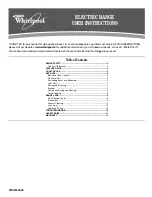
Care and Cleaning
Proper care and cleaning are
important so your range will give
you efficient and satisfactory
service. Follow these directions
carefully in caring for it to help
assure safe and proper maintenance.
IF YOUR RANGE HAS
ELECTRIC IGNITION, BE
SURE ELECTRIC POWER IS
DISCONNECTED BEFORE
CLEANING ANY PART OF IT.
Outer Painted Finish
When the range is cool, wash the
top, front and, if exposed, the sides
with mild soap and water. Never use
any harsh abrasives or cleaning
powders that may scratch or mar the
painted surface. Rinse the surface
with clean water and dry with a soft
cloth. If you wish, occasionally
apply a thin coat of mild cleaning
wax to help protect the finish.
Porcelain Cooktop
There are a number of precautions
you can take to avoid marring the
porcelain enamel surface of the
cooktop and to prevent it from
becoming dull. Don’t slide heavy
pans across it. If you spill foods
with a lot of acid (tomatoes,
sauerkraut, fruit juices, etc. ) or
foods with high sugar content,
clean them up as soon as possible.
If allowed to set, these foods could
cause a dull spot. Also, no matter
how stubborn the food stain, never
use harsh abrasive cleansers. They
could permanently damage the
enamel surface. We recommend a
cleanser such as “Soft
brand cleanser or a similar
cleaning product.
Soft Scrub” is a registered trademark of the
Company.
Control Panel
It’s a good idea to wipe the control
panel clean after each use of the
oven. For a more thorough cleaning,
the knobs can be removed by
pulling them off the knob stems.
Clean with mild soap and water,
rinse with clean water and polish
dry with a soft cloth.
Do not use abrasive cleansers,
strong liquid cleaners or oven
cleaners on the control
they will damage the finish.
Brushed Chrome Finish
(on model RGS525GEN)
Clean the brushed chrome top
with warm, soapy water or an
purpose household cleaner and
immediately dry it with a clean,
soft cloth. Take care to dry the
surface following the “grain.” To
help prevent finger marks after
cleaning, spread a thin film of baby
oil on the surface. Wipe away
excess oil with a clean, soft cloth.
A good appliance wax will help
protect this finish.
Burner Grates
Grates should be washed regularly
and, of course, after
Wash them in hot, soapy water and
rinse with clean water. Dry the
grates with a cloth—don’t put them
back on the range while they are
wet. When replacing the grates, be
sure they’re positioned securely
over the burners.
To get rid of burned-on food, soak
the grates in a slightly diluted
liquid detergent.
Although they’re durable, the
grates will gradually lose their
shine, regardless of the best care
you can give them. This is due to
their continual exposure to high
temperatures.
Do not operate a burner for an
extended period of time without
cookware on the grate. The finish
on the grate may chip without
cookware to absorb the heat.
Lift-Up Cooktop
Clean the area under the cooktop
often. Built-up soil, especially
grease, may catch on fire.
To make cleaning easier, the
cooktop maybe lifted up.
To raise the cooktop:
1.
Be sure burners are turned off.
2. Remove the grates.
3. Grasp the two front burner wells
and lift up.
Dual support rods will hold the
cooktop up while you clean
underneath it.
After cleaning under the cooktop
with hot, soapy water and a clean
cloth, lower the cooktop. Be
careful not to pinch your fingers.
Air Vents
Never block the vents (air
openings) of the range.
They
provide the air inlet and outlet
which is necessary for the range to
operate properly with correct
combustion. Air openings are
located in the following places:
—Oven vent at the rear of the
cooktop.
—Air intake under the broiler
drawer.
—Air vent at the top of the oven
door.
Quality of Flames
The combustion quality of pilot
(Standing Pilot models) and burner
flames needs to be determined
visually. See instructions on pages
8, 10,21 and 22.
16
















































